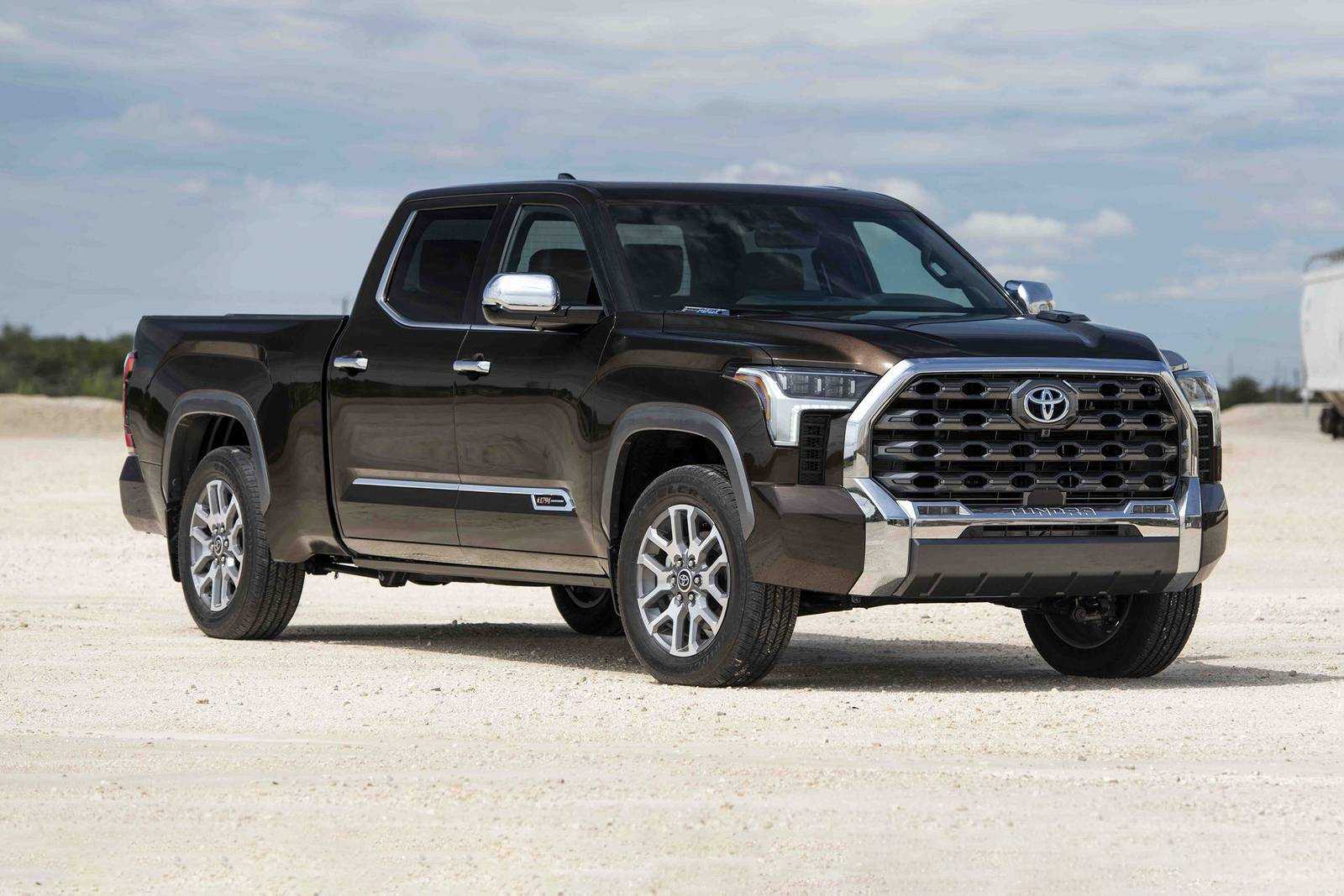2023 Toyota Tundra Parking Assist Sensors Owner’s Manual
Modern Parking Assist Sensors are included in the 2023 Toyota Tundra to improve safety and manoeuvrability in confined areas. These sensors give drivers immediate input to help them manoeuvre parking spaces easily and precisely. In the new Tundra, parking becomes a stress-free experience thanks to the seamless integration of modern technology.
2023 – 2024 Toyota Tundra Review Specs, Price And Mileage (Brochure)
Toyota Intuitive Parking Assist Guide
If Equipped
The distance from your vehicle to objects, such as a wall, when parallel parking or manoeuvring into a garage is measured by the sensors and communicated via the multi-informa-tion display and/or multimedia display and a buzzer. Always check the surrounding area when using this system.
System components
Types of sensors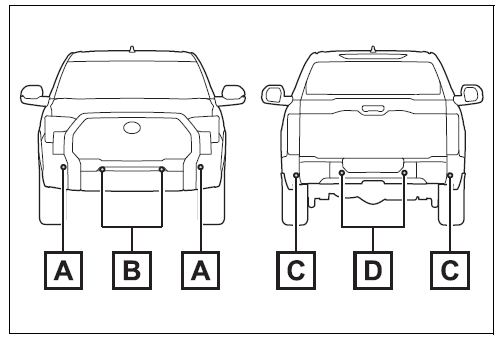
- Front corner sensors
- Front centre sensors
- Rear corner sensors
- Rear center sensors
Display
When the sensors detect an object, such as a wall, a graphic is shown on the multi-information display and/or multimedia display depending on the position and distance to the object. (As the distance to the object becomes short, the distance segments may blink.)
- Multi-information display
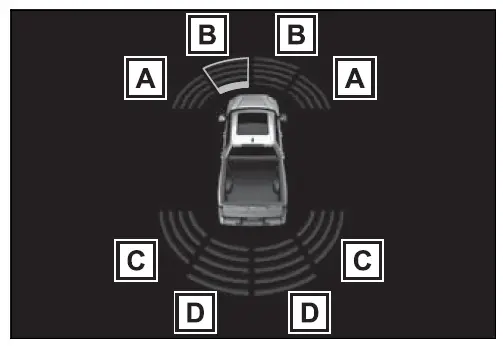
- Multimedia display
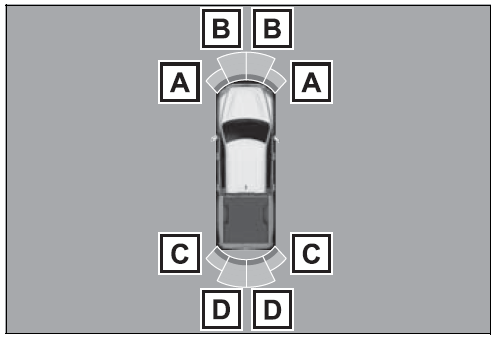
- Front corner sensor detection
- Front-center sensor detection
- Rear corner sensor detection
- Rear centre sensor detection
Turning intuitive parking assist on/off
Use the meter control switches to enable/disable the intuitive parking assist.
- Press or to select.
- Press or to select
When the intuitive parking assist function is disabled, the intuitive parking assist OFF indicator illuminates.
To re-enable the system when it is disabled, select the multi-information display, select and then On. If disabled using
this method, the system will not be re-enabled by turning the engine switch off and then to ON.
When towing a trailer
When the 7-pin connector is con-nected and Auto Trailer Detection (ATD) is activated, the rear sensor automatically turns off.
WARNING
Cautions regarding the use of the system
There is a limit to the degree of recognition accuracy and control performance that this system can provide, do not overly rely on this system. The driver is always responsible for paying attention to the vehicle’s surroundings and driving safely.
To ensure the system can operate properly
Observe the following precau-tions.
Failing to do so may result in the vehicle being unable to be driven safely and possibly cause an acci-dent.
- Do not damage the sensors, and always keep them clean.
WARNING
- Do not attach a sticker or install an electronic component, such as a backlit license plate (espe-cially fluorescent type), fog lights, fender pole or wireless antenna near a radar sensor.
- Do not subject the surrounding area of the sensor to a strong impact. If subjected to an impact, have the vehicle inspected by your Toyota dealer. If the front or rear bumper needs to be removed/installed or replaced, contact your Toyota dealer.
- Do not modify, disassemble or paint the sensors.
- Do not attach a license plate cover.
- Keep your tyres properly inflated.
When to disable the function
In the following situations, disable the function as it may operate even though there is no possibility of a collision.
- Failing to observe the warnings above.
- A non-genuine Toyota suspension (lowered suspension, etc.) is installed.
Notes when washing the vehi-cle
Do not apply intensive bursts of water or steam to the sensor area.
Doing so may result in the sensor malfunctioning.
- When using a high-pressure washer to wash the vehicle, do not spray the sensors directly, as doing so may cause a sensor to malfunction.
- When using steam to clean the vehicle, do not direct steam too close to the sensors as doing so may cause a sensor to malfunction.
The system can be operated when
- The engine switch is ON.
- The intuitive parking assist function is on.
- The vehicle speed is less than about 6 mph (10 km/h).
- A shift position other than P is selected.
If “Parking Assist Unavailable Clean Parking Assist Sensor” is displayed on the multi-informa-tion display
A sensor may be covered with water drops, ice, snow, dirt, etc. Remove the water drops, ice, snow, dirt, etc., from the sensor to return the system to normal.
Also, due to ice forming on a sensor at low temperatures, a warning message may be displayed or the sensor may not be able to detect an object. Once the ice melts, the sys-tem will return to normal.
If a warning message is displayed even if the sensor is clean, there may be a sensor malfunction. Have the vehicle inspected by your Toyota dealer.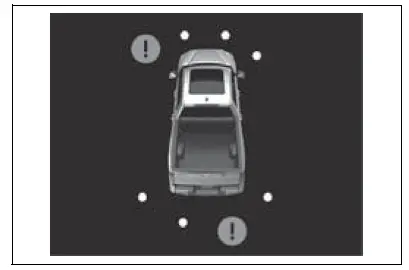
If “Parking Assist Unavailable” is displayed on the multi-information display
Water may be continuously flowing over the sensor surface, such as in heavy rain. When the system determines that it is normal, the sys-tem will return to normal.
Sensor detection information
- The sensor’s detection areas are limited to the areas around the vehicle’s front and rear bumpers.
- The following situations may occur during use.
- Depending on the shape of the object and other factors, the detection distance may shorten, or detection may be impossible.
- Detection may be impossible if static objects draw too close to the sensor.
- There will be a short delay between static object detection and display (warning buzzer sounds). Even at low speeds, there is a possibility that the object will come within 11.9 in. (30 cm) before the display is shown and the warning buzzer sounds.
- It might be difficult to hear the buzzer due to the volume of the audio system or the airflow noise of the air conditioning system.
- It may be difficult to hear the sound of this system due to the buzzers of other systems.
Objects which the system may not be properly detected
The shape of the object may prevent the sensor from detecting it. Pay particular attention to the following objects:
- Wires, fences, ropes, etc.
- Cotton, snow and other materials that absorb sound waves
- Sharply-angled objects
- Low objects
- Tall objects with upper sections projecting outwards in the direction of your vehicle
Situations in which the system may not operate properly
Certain vehicle conditions and the surrounding environment may affect the ability of a sensor to correctly detect objects. Particular instances where this may occur are listed below.
- There is dirt, snow, water drops or ice on a sensor. (Cleaning the sensors will resolve this problem.)
- A sensor is frozen. (Thawing the area will resolve this problem.)
In especially cold weather, if a sensor is frozen the sensor display
may be displayed abnormally, or objects, such as a wall, may not
be detected. - When a sensor or the area around a sensor is extremely hot or cold.
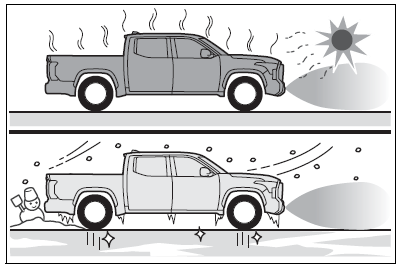
- On an extremely bumpy road, on an incline, on gravel, or grass.
- When vehicle horns, vehicle detectors, motorcycle engines, air brakes of large vehicles, the clear-ance sonar of other vehicles or other devices which produce ultra-sonic waves are near the vehicle
- A sensor is coated with a sheet of spray or heavy rain.
- If objects draw too close to the sensor.
- When a pedestrian is wearing clothing that does not reflect ultra-sonic waves (ex. skirts with gathers or frills).
- When objects that are not perpendicular to the ground, not perpendicular to the vehicle travelling direction, uneven, or waving are in the detection range.
- Strong wind is blowing
- When driving in inclement weather such as fog, snow or a sandstorm
- When an object that cannot be detected is between the vehicle and a detected object
- If an object such as a vehicle, motorcycle, bicycle or pedestrian cuts in front of the vehicle or runs out from the side of the vehicle
- If the orientation of a sensor has been changed due to a collision or other impact
- When equipment that may obstruct a sensor is installed, such as a towing eyelet, bumper protector (an additional trim strip, etc.), bicycle carrier, or snow plough
- If the front of the vehicle is raised or lowered due to the carried load
- If the vehicle cannot be driven in a stable manner, such as when the vehicle has been in an accident or is malfunctioning
- When a tyre chain, compact spare tyre or an emergency tyre puncture repair kit is used
- When the tailgate is opened
Situations in which the system may operate even if there is no possibility of a collision
In some situations, such as the following, the system may operate even though there is no possibility of a collision.
- When driving on a narrow road
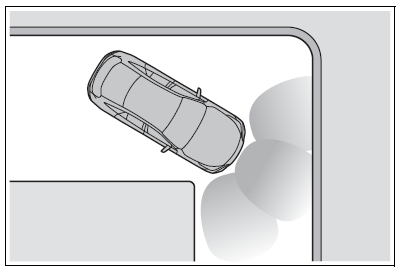
- When driving toward a banner, flag, low-hanging branch or boom barrier (such as those used at railroad crossings, toll gates and parking lots)
- When there is a rut or hole in the surface of the road
- When driving on a metal cover
(grating), such as those used for drainage ditches - When driving up or down a steep slope
- If a sensor is hit by a large amount of water, such as when driving on a flooded road
- There is dirt, snow, water drops or ice on a sensor. (Cleaning the sensors will resolve this problem.)
- A sensor is coated with a sheet of spray or heavy rain
- When driving in inclement weather such as fog, snow or a sandstorm
- When strong winds are blowing
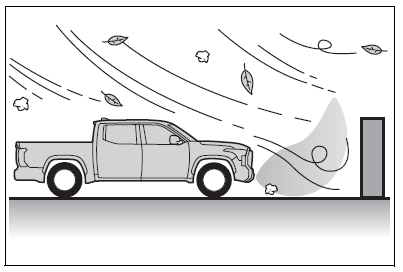
- When vehicle horns, vehicle detectors, motorcycle engines, air brakes of large vehicles, the clear-ance sonar of other vehicles or other devices which produce ultra-sonic waves are near the vehicle
- If the front of the vehicle is raised or lowered due to the carried load
- If the orientation of a sensor has been changed due to a collision or other impact
- The vehicle is approaching a tall or curved curb
- Driving close to columns (H-shaped steel beams, etc.) in multi-story parking garages, construction sites, etc.
- If the vehicle cannot be driven in a stable manner, such as when the vehicle has been in an accident or is malfunctioning
- On an extremely bumpy road, on an incline, on gravel, or grass
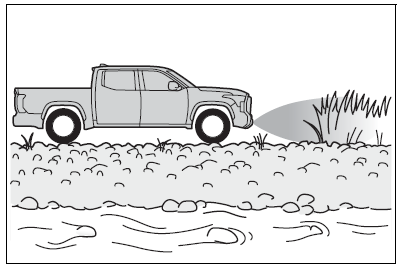
- When a tyre chain, compact spare tyre or an emergency tyre puncture repair kit is used
When towing a trailer
Rear sensors turn off when the trailer connection is detected.
When reversing, the rear sensors turn off, but the front corner sensors operate.
Certification
2023 – 2024 Toyota Tundra Review Specs, Price And Mileage (Brochure)
Sensor detection display, object distance
Detection range of the sensors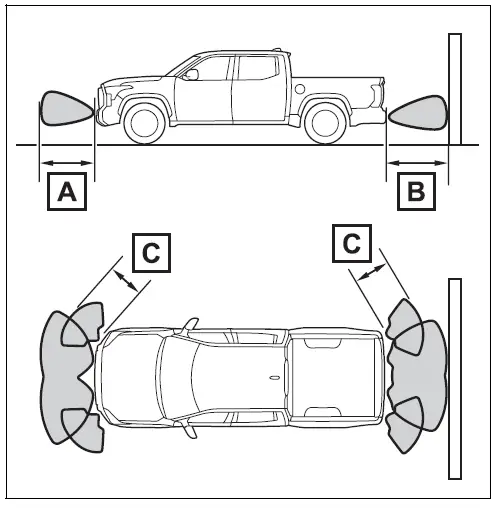
- Approximately 3.3 ft. (100 cm)
- Approximately 4.9 ft. (150 cm)
- Approximately 2.0 ft. (60 cm)
The diagram shows the detection range of the sensors. Note that the sensors cannot detect objects that are extremely close to the vehicle.
The range of the sensors may change depending on the shape of the object, etc.
The distance and buzzer
| Approximate distance to the obstacle | Buzzer |
| Front sensor: 3.3 ft. to 2.0 ft. (100 cm to 60 cm)* Rear sensor: 4.9 ft. to 2.0 ft. (150 cm to 60 cm)* |
Slow |
| 2.0 ft. to 1.5 ft. (60 cm to 45 cm)* | Medium |
| 1.5 ft. to 1.0 ft. (45 cm to 30 cm)* | Fast |
| 1.0 ft. to 0.5 ft. (30 cm to 15 cm) | Continuous |
| Less than 0.5 ft. (15 cm) |
The automatic buzzer mute function is enabled.
Buzzer operation and distance to an object
A buzzer sounds when the sensors are operating.
- The buzzer beeps faster as the vehicle approaches an object.
When the vehicle comes within approximately 1.0 ft.(30 cm) of the object, the buzzer sounds continuously. - When 2 or more sensors simultaneously detect a static object, the buzzer sounds for the nearest object.
- Even when the sensors are operating, the buzzer will be muted in some situations. (automatic buzzer mute func-tion)
Adjusting the buzzer volume
The buzzer volume can be adjusted on the multi-informa-tion display.
Use the meter control switches to change settings.
- Press the meter control switch to select.
- Press the meter control switch to select and then press and hold.
- Select the volume and then press.
Each time the switch is pressed, the volume level will change between 1, 2, and 3.
Muting a buzzer
A mute button will be displayed on the multi-information display when an object is detected. To mute the buzzer, press.
The buzzers for the intuitive parking assist and RCTA func-tion (if equipped) will be muted simultaneously.
Mute will be cancelled automati-cally in the following situations:
- When the shift position is changed.
- When the vehicle speed exceeds a certain speed.
- When there is a malfunction in a sensor or the system is temporarily unavailable.
- When the operating function is disabled manually.
- When the engine switch is turned off.
FAQs
The 2023 Toyota Tundra features ultrasonic parking assist sensors.
The 2023 Toyota Tundra is equipped with front and rear parking assist sensors.
Yes, parking assist sensors are standard across all trims of the 2023 Toyota Tundra.
No, the parking assist sensors in the 2023 Toyota Tundra are designed primarily for parking assistance and don’t detect blind spot objects.
The parking assist sensors in the 2023 Toyota Tundra use ultrasonic technology to detect objects around the vehicle.
Yes, the 2023 Toyota Tundra offers a rearview camera system that works in conjunction with the parking assist sensors.
Yes, drivers have the option to deactivate the parking assist sensors in the 2023 Toyota Tundra if desired.
The parking assist sensors in the 2023 Toyota Tundra offer both visual and audible warnings to alert the driver of nearby objects.
The parking assist sensors in the 2023 Toyota Tundra have a range of approximately six feet.
Yes, drivers can adjust the sensitivity of the parking assist sensors in the 2023 Toyota Tundra to suit their preferences.
Yes, the parking assist sensors in the 2023 Toyota Tundra are designed to withstand various weather conditions.
No, the parking assist sensors in the 2023 Toyota Tundra are intended for use during parking manoeuvres and do not operate while the vehicle is in motion.
Yes, the parking assist sensors in the 2023 Toyota Tundra are capable of detecting small objects including curbs.
The parking assist sensors in the 2023 Toyota Tundra may not detect objects located very close to the vehicle or those that are too low to the ground.
Yes, the parking assist sensors are typically covered under the vehicle’s warranty in the 2023 Toyota Tundra.
It may be possible to retrofit parking assist sensors onto older models of the Toyota Tundra.
Useful Links
View Full PDF: Toyota Tundra 2023 User Guide | Auto User Guide
2023 – 2024 Toyota Tundra Review Specs, Price And Mileage (Brochure)

